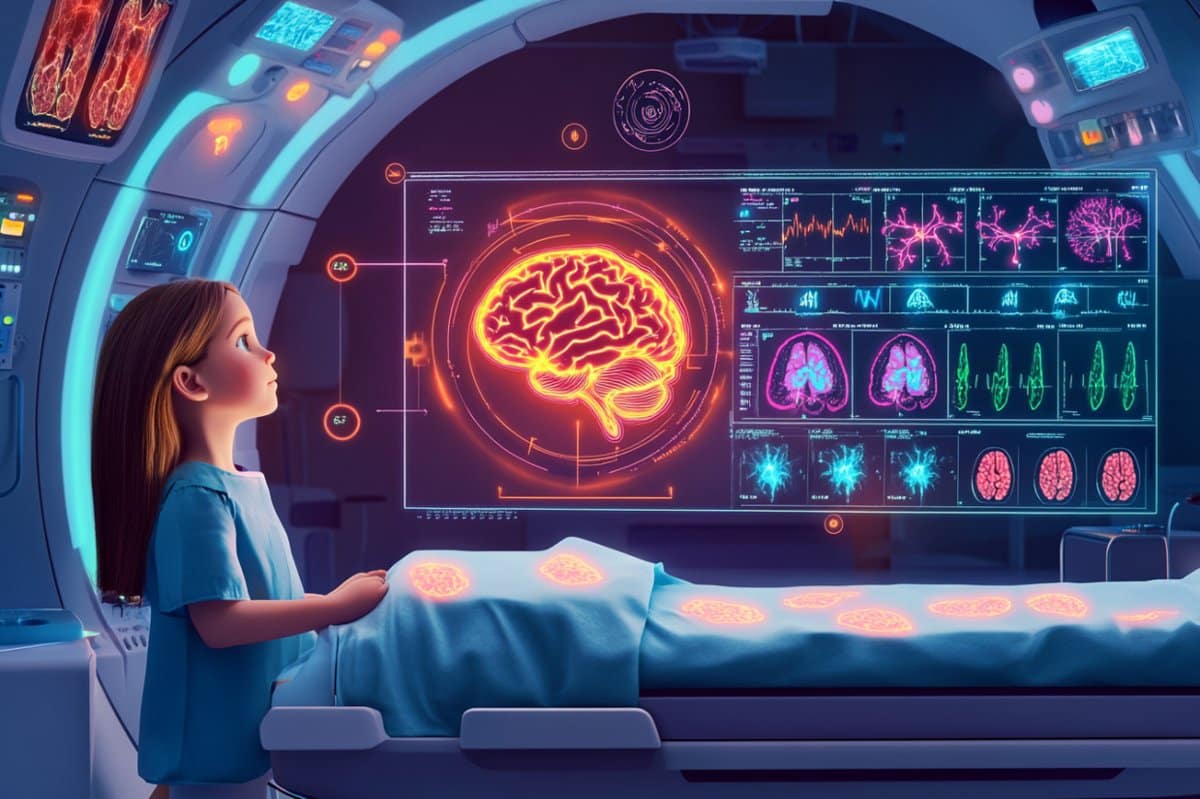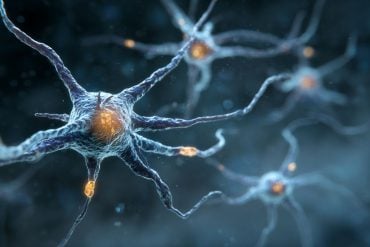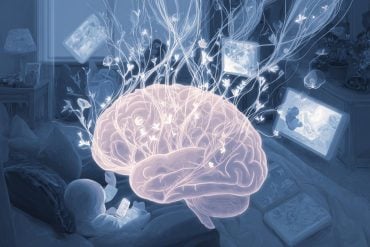Summary: Researchers have developed an AI model that analyzes sequences of brain scans to accurately predict tumor recurrence in children with gliomas. By applying a method called temporal learning, the model interprets subtle changes in MR images taken post-treatment over time.
The study found that using multiple images significantly outperforms traditional single-scan analysis, reaching prediction accuracy rates as high as 89%. This approach could one day reduce the burden of frequent scans or enable earlier interventions.
Key Facts:
- Temporal Learning Advantage: AI trained on multiple post-treatment MRIs predicted recurrence with up to 89% accuracy.
- Efficient Imaging: Just 4–6 scans were enough to plateau the AI’s predictive power.
- Clinical Potential: Could reduce scan frequency for low-risk patients or enable early treatment for high-risk cases.
Source: Mass General
Artificial intelligence (AI) shows tremendous promise for analyzing vast medical imaging datasets and identifying patterns that may be missed by human observers.
AI-assisted interpretation of brain scans may help improve care for children with brain tumors called gliomas, which are typically treatable but vary in risk of recurrence.

Investigators from Mass General Brigham and collaborators at Boston Children’s Hospital and Dana-Farber/Boston Children’s Cancer and Blood Disorders Center trained deep learning algorithms to analyze sequential, post-treatment brain scans and flag patients at risk of cancer recurrence.
Their results are published in The New England Journal of Medicine AI.
“Many pediatric gliomas are curable with surgery alone, but when relapses occur, they can be devastating,” said corresponding author Benjamin Kann, MD, of the Artificial Intelligence in Medicine (AIM) Program at Mass General Brigham and the Department of Radiation Oncology at Brigham and Women’s Hospital.
“It is very difficult to predict who may be at risk of recurrence, so patients undergo frequent follow-up with magnetic resonance (MR) imaging for many years, a process that can be stressful and burdensome for children and families. We need better tools to identify early which patients are at the highest risk of recurrence.”
Studies of relatively rare diseases, like pediatric cancers, can be challenged by limited data. This study, which was funded in part by the National Institutes of Health, leveraged institutional partnerships across the country to collect nearly 4,000 MR scans from 715 pediatric patients.
To maximize what AI could “learn” from a patient’s brain scans — and more accurately predict recurrence — the researchers employed a technique called temporal learning, which trains the model to synthesize findings from multiple brain scans taken over the course of several months post-surgery.
Typically, AI models for medical imaging are trained to draw conclusions from single scans; with temporal learning, which has not previously been used for medical imaging AI research, images acquired over time inform the algorithm’s prediction of cancer recurrence.
To develop the temporal learning model, the researchers first trained the model to sequence a patient’s post-surgery MR scans in chronological order so that the model could learn to recognize subtle changes.
From there, the researchers fine-tuned the model to correctly associate changes with subsequent cancer recurrence, where appropriate.
Ultimately, the researchers found that the temporal learning model predicted recurrence of either low- or high-grade glioma by one-year post-treatment, with an accuracy of 75-89 percent — substantially better than the accuracy associated with predictions based on single images, which they found to be roughly 50 percent (no better than chance).
Providing the AI with images from more timepoints post-treatment increased the model’s prediction accuracy, but only four to six images were required before this improvement plateaued.
The researchers caution that further validation across additional settings is necessary prior to clinical application.
Ultimately, they hope to launch clinical trials to see if AI-informed risk predictions can result in improvements to care — whether by reducing imaging frequency for the lowest-risk patients or by preemptively treating high-risk patients with targeted adjuvant therapies.
“We have shown that AI is capable of effectively analyzing and making predictions from multiple images, not just single scans,” said first author Divyanshu Tak, MS, of the AIM Program at Mass General Brigham and the Department of Radiation Oncology at the Brigham.
“This technique may be applied in many settings where patients get serial, longitudinal imaging, and we’re excited to see what this project will inspire.”
Authorship: In addition to Kann and Tak, Mass General Brigham authors include Biniam A. Garomsa, Anna Zapaishchykova, Zezhong Ye, Maryam Mahootiha, Tafadzwa Chaunzwa, Hugo JWL Aerts, and Daphne Haas-Kogan. Additional authors include Sridhar Vajapeyam, Juan Carlos Climent Pardo, Ceilidh Smith, Ariana M. Familiar, Kevin X. Liu, Sanjay Prabhu, Pratiti Bandopadhayay, Ali Nabavizadeh, Sabine Mueller, and Tina Y. Poussaint,
Funding: This study was supported in part by the National Institute of Health/ the National Cancer Institute (NIH/NCI) (U54 CA274516 and P50 CA165962), and Botha-Chan Low Grade Glioma Consortium. We would also like to acknowledge the Children’s Brain Tumor Network (CBTN) for the imaging and clinical data access.
About this brain cancer and AI research news
Author: Alexandra Pantano
Source: Mass General
Contact: Alexandra Pantano – Mass General
Image: The image is credited to Neuroscience News
Original Research: Closed access.
“Longitudinal Risk Prediction for Pediatric Glioma with Temporal Deep Learning” by Benjamin Kann et al. NEJM AI
Abstract
Longitudinal Risk Prediction for Pediatric Glioma with Temporal Deep Learning
Background
Pediatric glioma recurrence can cause morbidity and mortality; however, recurrence patterns and severity are heterogeneous and challenging to predict with established clinical and genomic markers. As a result, almost all children undergo frequent, long-term, magnetic resonance imaging (MRI) brain surveillance regardless of individual recurrence risk.
Longitudinal deep-learning analysis of serial MRI scans may be an effective approach for improving individualized recurrence prediction in gliomas and other cancers, but, thus far, progress has been limited by data availability and current machine-learning approaches.
Methods
We developed a self-supervised temporal deep-learning approach tailored for longitudinal medical imaging analysis, wherein a multistep model encodes patients’ serial MRI scans and is trained to classify the correct chronological order as a pretext task.
The pretrained model is then fine-tuned to predict the primary end point of interest — in this case, 1-year recurrence prediction for pediatric gliomas from the point of last scan — by leveraging a patient’s historical postoperative surveillance scans.
We apply the model across 3994 scans from 715 patients followed at three separate institutions in the setting of pediatric low- and high-grade gliomas.
Results
Longitudinal imaging analysis with temporal learning improved recurrence prediction performance (F1 score) by up to 58.5% (range, 6.6 to 58.5%) compared with traditional approaches across datasets, with performance improvements in both low- and high-grade gliomas and area under the receiver operating characteristic curve of (range, 75 to 89%) across all datasets.
Recurrence prediction performance increased incrementally with the number of historical scans available per patient, reaching plateaus between three and six scans, depending on the dataset.
Conclusions
Temporal deep learning enables high-performing longitudinal medical imaging analysis and point-of-care decision support for pediatric brain tumors. Temporal learning may be broadly adaptable to track and predict risk in patients with other cancers and chronic diseases undergoing surveillance imaging.
(Funded in part by the National Institutes of Health/National Cancer Institute (U54 CA274516 and P50 CA165962), and Botha-Chan Low Grade Glioma Consortium.)






